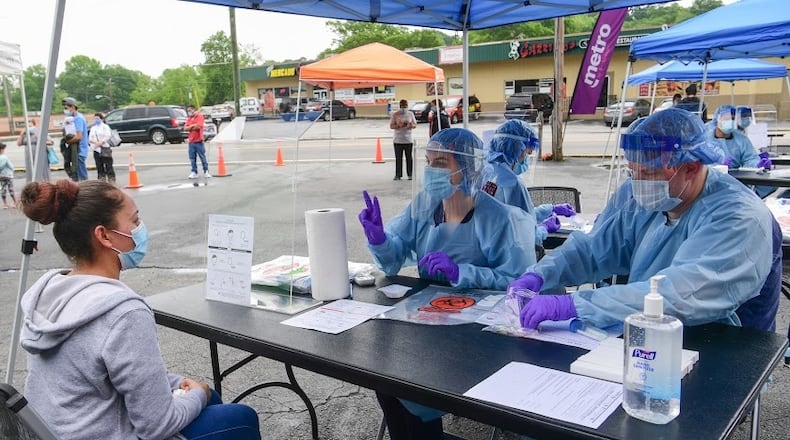Gov. Brian Kemp and the state’s top doctor urged all Georgians, especially those who participated in large Labor Day weekend gatherings, to get tested for the coronavirus.
State officials had urged Georgians to avoid large gatherings over the holiday weekend and reminded residents to keep their distance from others, wear masks and wash hands to help reduce the risk of another surge in cases like what was seen in the weeks after Memorial Day weekend stretching into July.
The Georgia Department of Public Health (DPH) and local health departments operate more than 180 testing sites around the state. To schedule a test, Georgians can visit the DPH website or go to DoINeedACOVID19Test.com.
Georgia has been on a downward trajectory in new cases of the virus for the past eight weeks after peaking in July. As cases have declined, test demand has also dipped. But test appointments are more widely available, and state and local health departments have reported results are returned typically in a few days, a significant improvement over longer wait times during the summer surge.
A White House Coronavirus Task Force report dated Sept. 6 ranked Georgia 12th in new cases for the seven days that ended on the previous Friday. Georgia had ranked first in the nation in new cases in the White House task force assessment dated Aug. 16.
While the task force report shows that Georgia is making steady improvements in containing the spread of the disease, it places a focus on stemming the outbreak in colleges, recommending that Georgia schools beef up testing and urge students who are exposed to the disease to self-quarantine on campus rather than in their hometowns.
Here’s a look at other major developments over the past week related to the coronavirus.
UGA reports a big increase in cases
The University of Georgia reported another significant increase in reported positive COVID-19 cases.
Georgia’s flagship university reported 1,417 positive cases between Aug. 31 and Sept. 4, according to a weekly update posted on its website. The university last week reported 821 positive cases from Aug. 24-28, which had been its highest five-day total since the pandemic began in March.
The website does not include data detailing the severity of the cases, information UGA, and other universities say they cannot release due to federal health privacy restrictions.
About one-half of the Aug. 31-Sept. 4 cases were reported by students who were tested off-campus.
The university also announced it is increasing its free testing for students and employees who do not have apparent symptoms of the disease, from 360 tests per weekday to 450. Health experts have said many asymptomatic people have unknowingly contracted COVID-19 and shared it with others.
Credit: HYOSUB SHIN / AJC
Credit: HYOSUB SHIN / AJC
Meanwhile, some colleges, including Georgia College and Georgia Tech, which had high numbers of cases in August, saw lower totals in the week ending Sept. 4.
State wants weekly reports on schools' coronavirus cases
Georgia is now gathering a weekly snapshot of coronavirus infections in public schools as part of the effort to contain the spread of COVID-19.
Although schools have been sharing case counts and other information with public health officials, this is the first effort to establish a uniform report for all 180 school districts. The directions ask that information from every school be sent to the state health agency by 5 p.m. each Friday.
Credit: HYOSUB SHIN / AJC
Credit: HYOSUB SHIN / AJC
The reports, which started Aug. 28, will allow the Georgia Department of Public Health to monitor the spread of the disease within each school, helping to identify effective prevention and control measures, spokeswoman Nancy Nydam explained by email. Schools already had to report much of this information to district health officials (there are 18 such districts), Nydam said, but this new call for reporting will allow the state to harvest other information, such as mitigation strategies used.
Schools should report not only their number of laboratory-confirmed cases but also “clusters” of cases. They should also report the number of people in quarantine. If close contacts were not quarantined, the school is supposed to explain why.
Traffic rebound on U.S. airlines slows despite Labor Day bump
Americans are still mostly avoiding airplanes amid the coronavirus pandemic, despite a busy Labor Day, according to the latest traffic reports.
Passenger traffic on U.S. airlines was down 73% in July from a year earlier, the U.S. Bureau of Transportation Statistics said Tuesday.
That’s improved from the year-over-year declines seen in April, May and June, when airline passenger traffic was down 96%, 90% and 80% respectively.
But the recovery appeared to stall in August and early September, when year-over-year declines in passenger counts were still in the 70% range on some days, according to Transportation Security Administration data on people passing through airport security checkpoints.
The Labor Day holiday weekend brought some significant increases in traffic through airports, with more than 900,000 passengers on both Monday and last Friday. That’s the first time passenger counts have exceeded 900,000 since March 17, but still down from more than 2 million passengers on the same days a year ago.
Staff writers J. Scott Trubey, Ty Tagami, Greg Bluestein and Kelly Yamanouchi contributed to this report.
About the Author
The Latest
Featured






